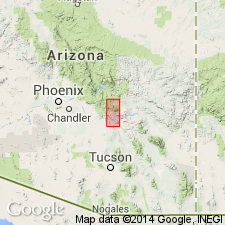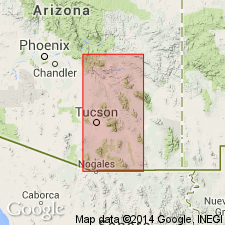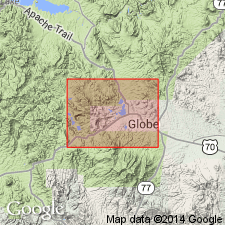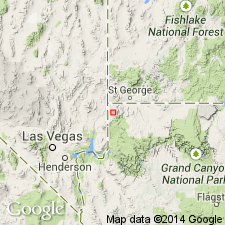
- Usage in publication:
-
- Schultze granite*
- Modifications:
-
- First used
- Dominant lithology:
-
- Granite
- AAPG geologic province:
-
- Basin-and-Range province
Summary:
First published use as name for a granite or granitite that is coarse granular aggregate of quartz, orthoclase and mica. Usually exposed in deep, rugged ravines, and is strongly jointed. Name derived from Schultze ranch, T2S, R14E, Gila Co, AZ in Basin-and-Range province. No type locality designated. Exposed from west side of quad north of Hutton Peak, Pinal Co and exposures trend generally northeast into Gila Co to the joining of Liveoak Gulch and Bloody Tanks Wash. Geologic map. Is younger than Madera diorite (first used) and than the Solitude granite (first used) because Schultze dikes cut both Madera and Solitude. Assigned to the pre-Cambrian.
Source: GNU records (USGS DDS-6; Denver GNULEX).

- Usage in publication:
-
- Schultze granite*
- Modifications:
-
- Age modified
- AAPG geologic province:
-
- Basin-and-Range province
Summary:
Occupies an area that has developed into broad basins and moderate slopes. Covered by vegetation so that the rounded outcrops covered by loose feldspar, quartz, and mica give a pale-yellow tint to the landscape. Characterized by its porphyritic texture. Phenocrysts of orthoclase, quartz, plagioclase and biotite are in an extremely fine granular groundmass. No conclusive evidence for its age, but rocks of this character now known to be younger than the diabase which is early Mesozoic or late Paleozoic. Is probably post-Cambrian, probably Tertiary. Geologic map; mapped with other Tertiary granites and granite porphyries, Gila and Pinal Cos, AZ in the Basin-and-Range province.
Source: GNU records (USGS DDS-6; Denver GNULEX).

- Usage in publication:
-
- Schultze Granite*
- Modifications:
-
- Geochronologic dating
- AAPG geologic province:
-
- Basin-and-Range province
Summary:
Schultze Granite. Present in the Globe-Miami district, Gila County, Arizona. Sample from granite porphyry (thought to be related to Schultze) that cuts the Lost Gulch Quartz Monzonite, yielded a K-Ar age of 58 Ma (biotite). [Paleocene]
Source: Modified from GNU records (USGS DDS-6; Denver GNULEX).

- Usage in publication:
-
- Schultze Granite*
- Modifications:
-
- Overview
- Age modified
- AAPG geologic province:
-
- Basin-and-Range province
Summary:
The granite mass has the form of an irregular stock. Crops out along the southern boundary of the Inspiration quad and northern part of Pinal Ranch quad, near Globe, Gila Co, AZ in the Basin-and-Range province. Forms rugged prominently jointed outcrops characterized by broad valleys and rounded hills. Is in contact with Pinal Schist around the greater portion of its boundaries. Where the general trend of boundary is parallel to bedding of foliation of schist, the contact is irregular. Where the general trend of the boundary crosscuts the bedding of the schist, the contact is regular. Joint patterns discussed. Chemical analyses. Includes several bodies of granite porphyry, a marginal facies of the main mass. Intrudes Lost Creek quartz monzonite and Willow Spring granodiorite. Intrudes Precambrian granite. Is younger than Whitetail conglomerate. Considered to be the youngest rocks emplaced during a series of intrusions that began in Late Cretaceous and continued into the early Tertiary. Shown as both of these ages on the geologic map.
Source: GNU records (USGS DDS-6; Denver GNULEX).

- Usage in publication:
-
- Schultze Granite*
- Modifications:
-
- Age modified
- Overview
- AAPG geologic province:
-
- Basin-and-Range province
Summary:
Crops out over 17 sq mi in west part of district and in isolated masses, AZ in the Basin-and-Range province. Is a composite pluton with early equigranular, main porphyritic, and late porphyry phases. Early phase is a granodiorite composed of quartz, plagioclase, potassium feldspar and biotite. The main phase is porphyritic quartz monzonite consisting of large potassium feldspar phenocrysts set in medium- to coarse-grained hypidiomorphic granular groundmass of plagioclase, quartz, potassium feldspar, and biotite. Geologic map. Cross section. Fifteen K-Ar ages of the different phases reported. Main phase has an age of 61.0 +/-0.7 m.y. Late phase gave ages of 59.2 +/-0.7 m.y., 64.4 +/-0.7 m.y., and 61.9 +/-0.7 m.y. Heat from the Schultze reset the isotopic ages of some of the older plutons (of Precambrian age). Age of Schultze changed from Tertiary? to early Tertiary.
Source: GNU records (USGS DDS-6; Denver GNULEX).

- Usage in publication:
-
- Schultze Granite*
- Modifications:
-
- Areal extent
- Overview
- AAPG geologic province:
-
- Basin-and-Range province
Summary:
Schultze Granite. Exposed in area of about 44 sq mi in western part of Globe-Miami district, Gila County, Arizona. Divided into five primary phases: (1) early phase, granodiorites ranging from porphyritic to hypidiomorphic seriate; (2) main phase, porphyritic quartz monzonite; (3) porphyry phase, contiguous to main phase; (4) dike phase, a central nonporphyritic zone grading into porphyritic borders; and (5) transitional phase, between main and porphyry phase. Intrudes several Proterozoic units (e.g., Pinal Schist, Willow Spring Granodiorite, Solitude Granite, Lost Gulch Quartz Monzonite) and a Paleozoic limestone. Unconformably underlies Whitetail Conglomerate, Apache Leap Tuff, and Tertiary and Quaternary rocks. Age is Paleocene; K-Ar ages from 64.4 +/-0.7 Ma to 59.2 +/-0.7 Ma. Report includes geologic map, chemical analyses.
Source: Modified from GNU records (USGS DDS-6; Denver GNULEX).
For more information, please contact Nancy Stamm, Geologic Names Committee Secretary.
Asterisk (*) indicates published by U.S. Geological Survey authors.
"No current usage" (†) implies that a name has been abandoned or has fallen into disuse. Former usage and, if known, replacement name given in parentheses ( ).
Slash (/) indicates name conflicts with nomenclatural guidelines (CSN, 1933; ACSN, 1961, 1970; NACSN, 1983, 2005, 2021). May be explained within brackets ([ ]).

